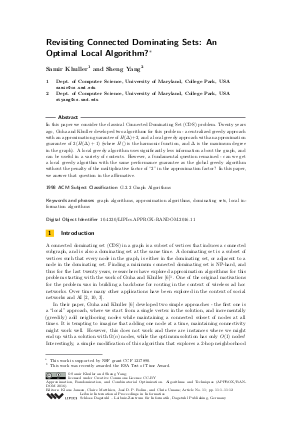Revisiting Connected Dominating Sets: An Optimal Local Algorithm?
Authors Samir Khuller, Sheng Yang
-
Part of:
Volume:
Approximation, Randomization, and Combinatorial Optimization. Algorithms and Techniques (APPROX/RANDOM 2016)
Part of: Series: Leibniz International Proceedings in Informatics (LIPIcs)
Part of: Conference: International Conference on Randomization and Computation (RANDOM)
Part of: Conference: International Conference on Approximation Algorithms for Combinatorial Optimization Problems (APPROX) - License:
 Creative Commons Attribution 3.0 Unported license
Creative Commons Attribution 3.0 Unported license
- Publication Date: 2016-09-06
File

PDF
LIPIcs.APPROX-RANDOM.2016.11.pdf
- Filesize: 466 kB
- 12 pages
Document Identifiers
Subject Classification
Keywords
- graph algorithms
- approximation algorithms
- dominating sets
- local information algorithms
Metrics
- Access Statistics
-
Total Accesses (updated on a weekly basis)
0PDF Downloads0Metadata Views
Abstract
In this paper we consider the classical Connected Dominating Set (CDS) problem. Twenty years ago, Guha and Khuller developed two algorithms for this problem - a centralized greedy approach with an approximation guarantee of H(D) +2, and a local greedy approach with an approximation guarantee of 2(H(D)+1) (where H() is the harmonic function, and D is the maximum degree in the graph). A local greedy algorithm uses significantly less information about the graph, and can be useful in a variety of contexts. However, a fundamental question remained - can we get a local greedy algorithm with the same performance guarantee as the global greedy algorithm without the penalty of the multiplicative factor of "2" in the approximation factor? In this paper, we answer that question in the affirmative.
Cite As Get BibTex
Samir Khuller and Sheng Yang. Revisiting Connected Dominating Sets: An Optimal Local Algorithm?. In Approximation, Randomization, and Combinatorial Optimization. Algorithms and Techniques (APPROX/RANDOM 2016). Leibniz International Proceedings in Informatics (LIPIcs), Volume 60, pp. 11:1-11:12, Schloss Dagstuhl – Leibniz-Zentrum für Informatik (2016)
https://doi.org/10.4230/LIPIcs.APPROX-RANDOM.2016.11
BibTex
@InProceedings{khuller_et_al:LIPIcs.APPROX-RANDOM.2016.11,
author = {Khuller, Samir and Yang, Sheng},
title = {{Revisiting Connected Dominating Sets: An Optimal Local Algorithm?}},
booktitle = {Approximation, Randomization, and Combinatorial Optimization. Algorithms and Techniques (APPROX/RANDOM 2016)},
pages = {11:1--11:12},
series = {Leibniz International Proceedings in Informatics (LIPIcs)},
ISBN = {978-3-95977-018-7},
ISSN = {1868-8969},
year = {2016},
volume = {60},
editor = {Jansen, Klaus and Mathieu, Claire and Rolim, Jos\'{e} D. P. and Umans, Chris},
publisher = {Schloss Dagstuhl -- Leibniz-Zentrum f{\"u}r Informatik},
address = {Dagstuhl, Germany},
URL = {https://drops.dagstuhl.de/entities/document/10.4230/LIPIcs.APPROX-RANDOM.2016.11},
URN = {urn:nbn:de:0030-drops-66340},
doi = {10.4230/LIPIcs.APPROX-RANDOM.2016.11},
annote = {Keywords: graph algorithms, approximation algorithms, dominating sets, local information algorithms}
}
Author Details
References
-
Konstantin Avrachenkov, Prithwish Basu, Giovanni Neglia, Bernardete Ribeiro, and Don Towsley. Pay few, influence most: Online myopic network covering. In Computer Communications Workshops (INFOCOM WKSHPS), 2014 IEEE Conference on, pages 813-818. IEEE, 2014.

-
Christian Borgs, Michael Brautbar, Jennifer Chayes, Sanjeev Khanna, and Brendan Lucier. The power of local information in social networks. In Internet and Network Economics, pages 406-419. Springer, 2012.

-
Ding-Zhu Du and Peng-Jun Wan. Connected dominating set: theory and applications, volume 77. Springer Science &Business Media, 2012.

-
Devdatt Dubhashi, Alessandro Mei, Alessandro Panconesi, Jaikumar Radhakrishnan, and Aravind Srinivasan. Fast distributed algorithms for (weakly) connected dominating sets and linear-size skeletons. In Proceedings of the fourteenth annual ACM-SIAM symposium on Discrete algorithms, pages 717-724. Society for Industrial and Applied Mathematics, 2003.

-
Uriel Feige. A threshold of ln n for approximating set cover. Journal of the ACM (JACM), 45(4):634-652, 1998.

-
Sudipto Guha and Samir Khuller. Approximation algorithms for connected dominating sets. Algorithmica, 20(4):374-387, 1998.

-
Sudipto Guha and Samir Khuller. Improved methods for approximating node weighted steiner trees and connected dominating sets. Information and computation, 150(1):57-74, 1999.

-
Samir Khuller, Manish Purohit, and Kanthi K Sarpatwar. Analyzing the optimal neighborhood: algorithms for budgeted and partial connected dominating set problems. In Proceedings of the Twenty-Fifth Annual ACM-SIAM Symposium on Discrete Algorithms, pages 1702-1713. SIAM, 2014.

-
Yuzhen Liu and Weifa Liang. Approximate coverage in wireless sensor networks. In Local Computer Networks, 2005. 30th Anniversary. The IEEE Conference on, pages 68-75. IEEE, 2005.

-
Adish Singla, Eric Horvitz, Pushmeet Kohli, Ryen White, and Andreas Krause. Information gathering in networks via active exploration. In Proceedings of the 24th International Conference on Artificial Intelligence, pages 981-988. AAAI Press, 2015.

